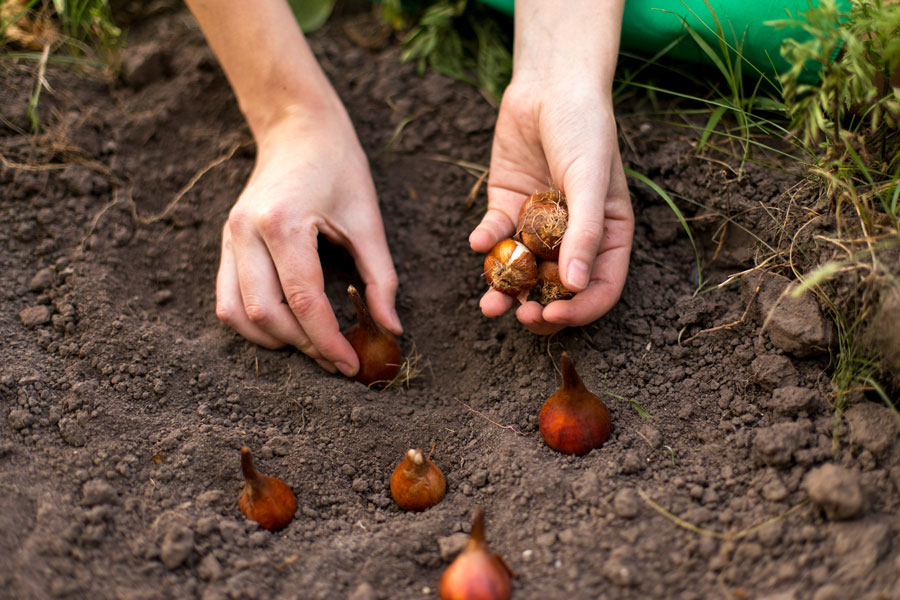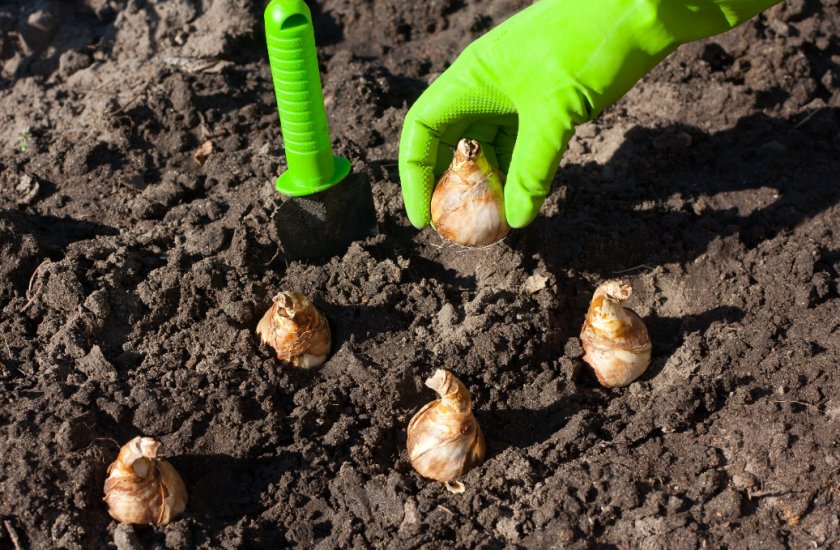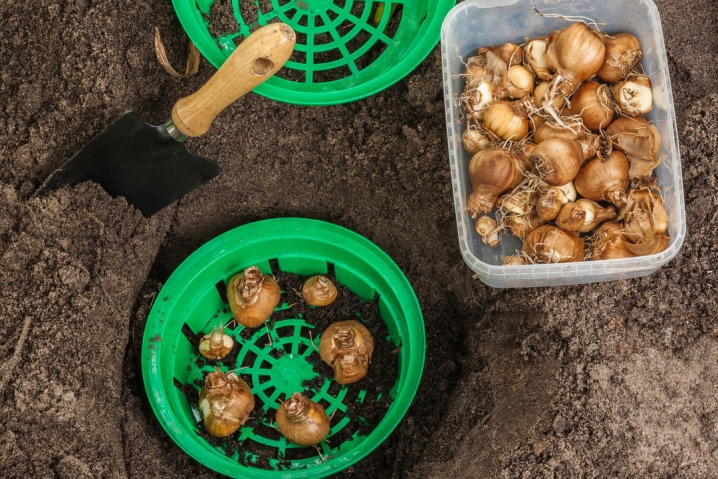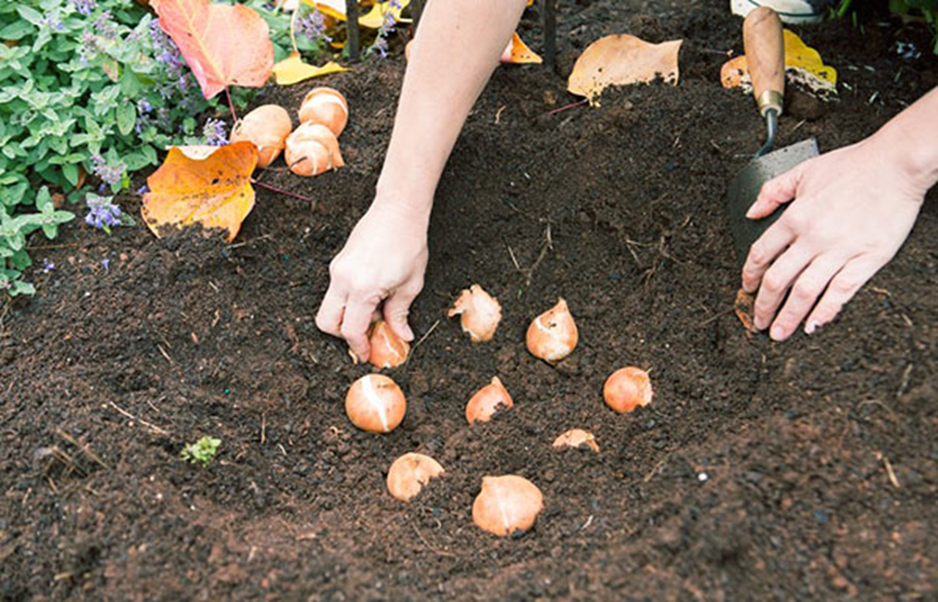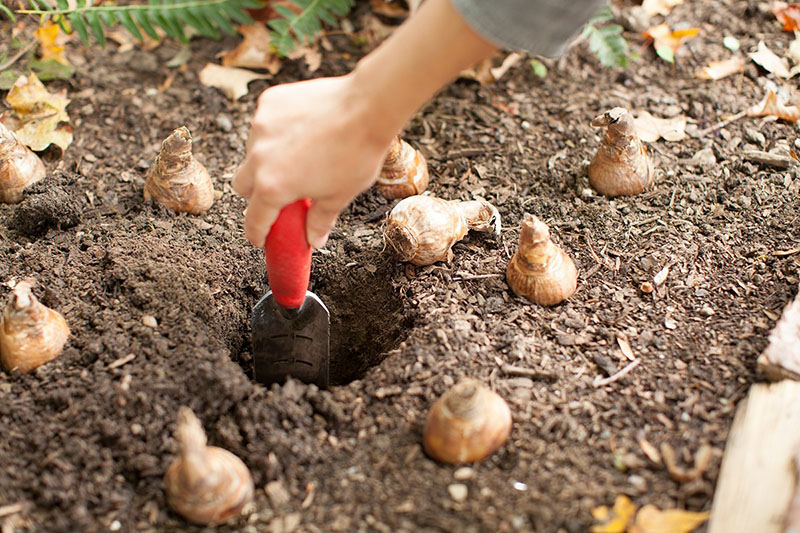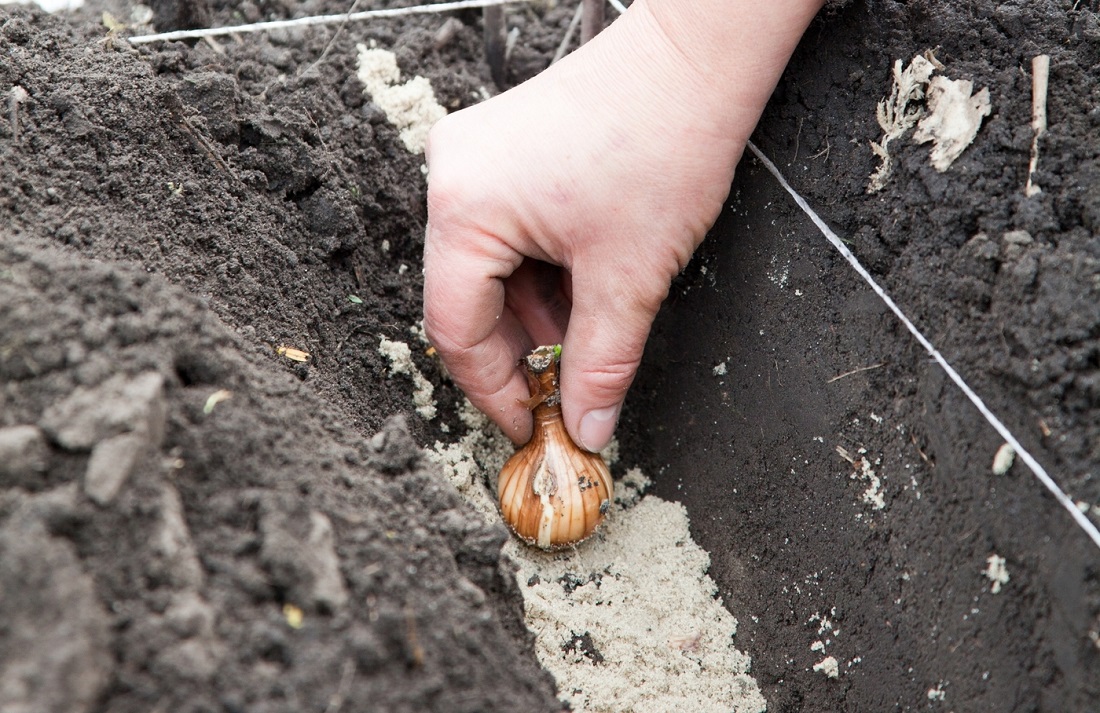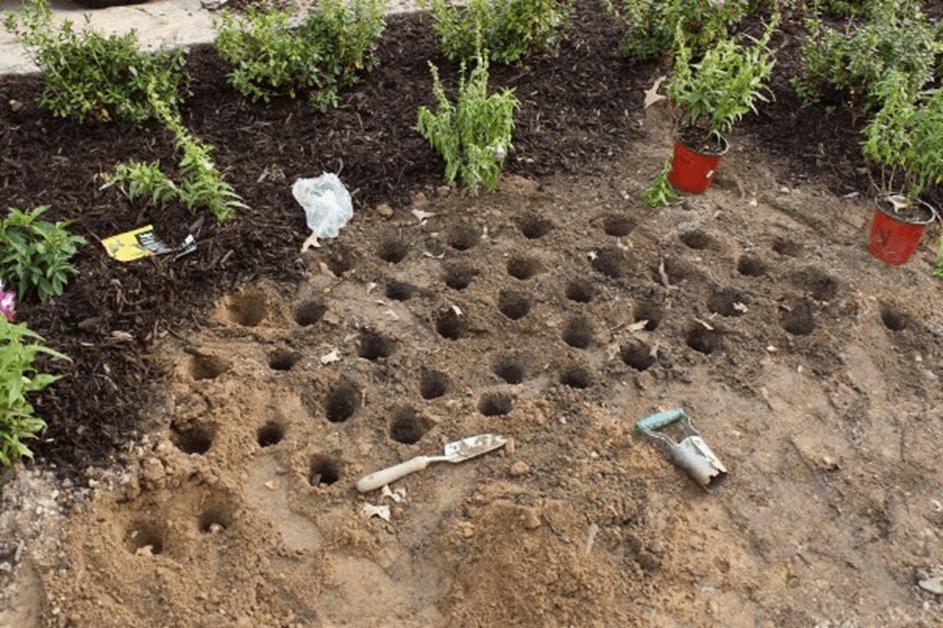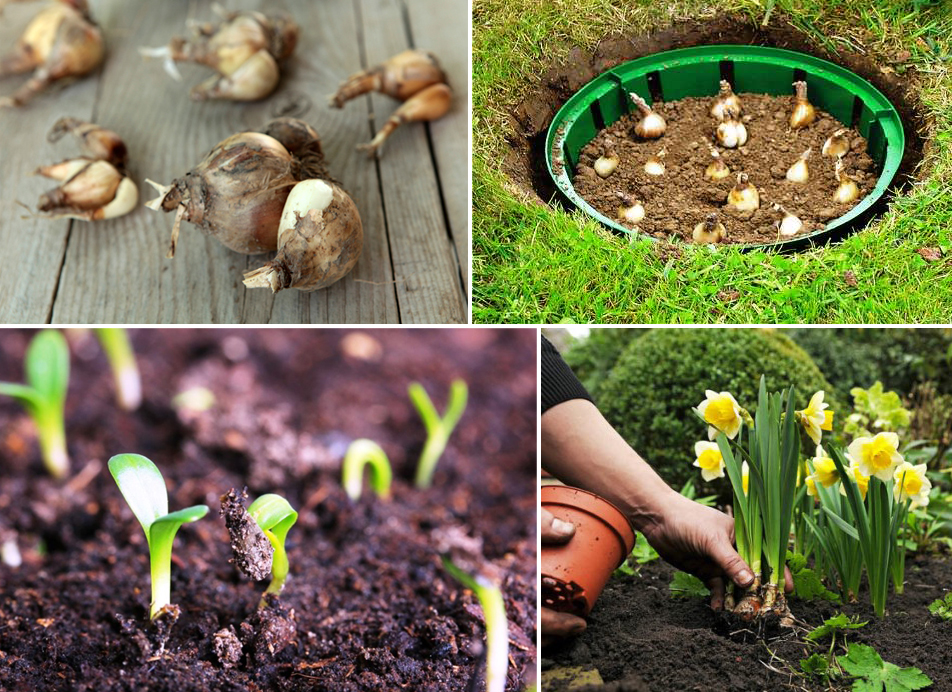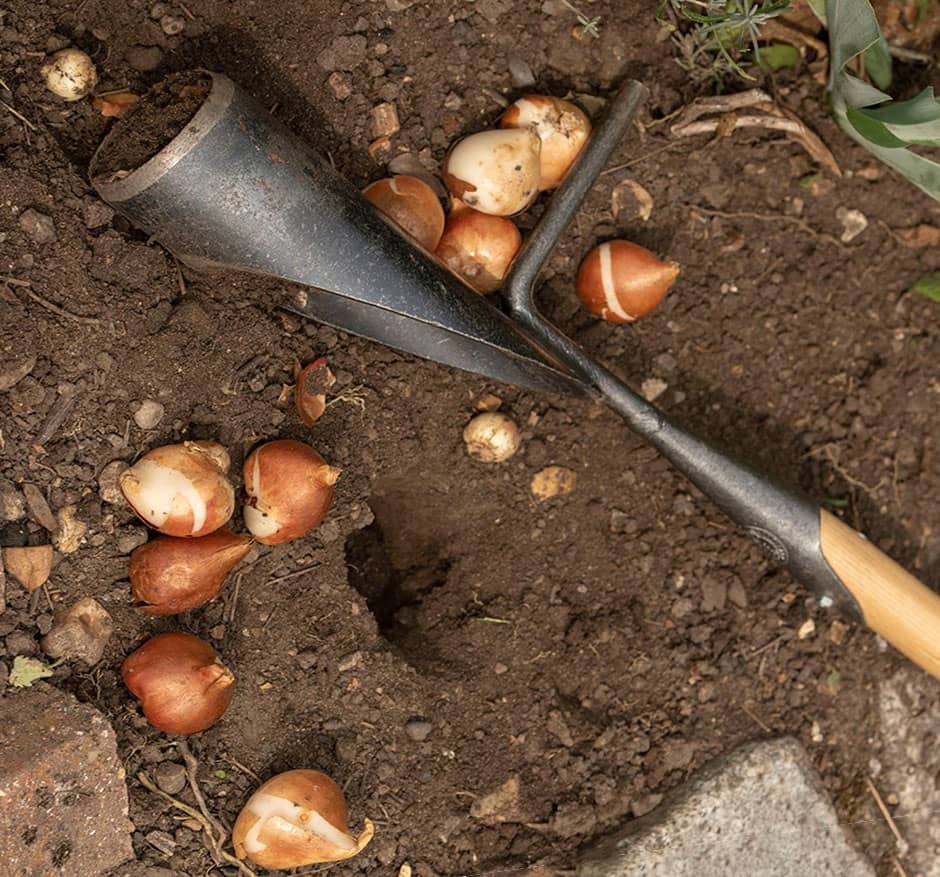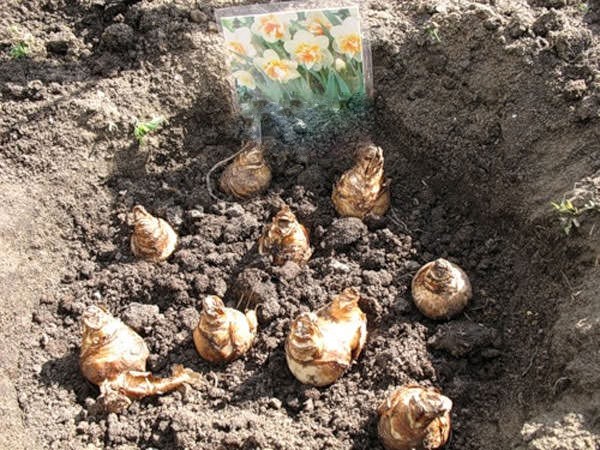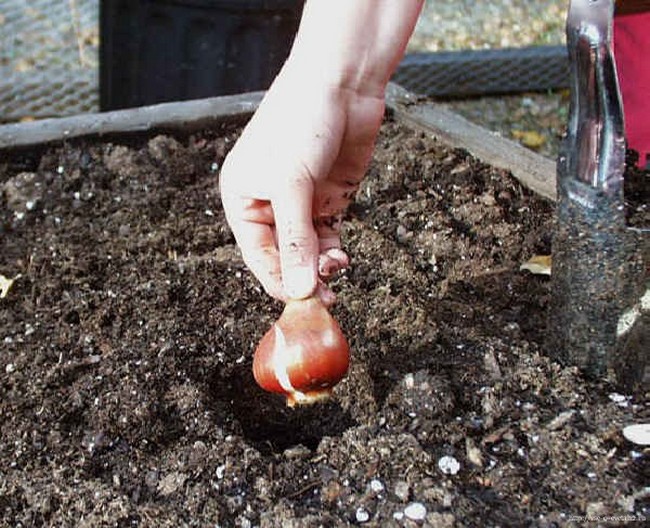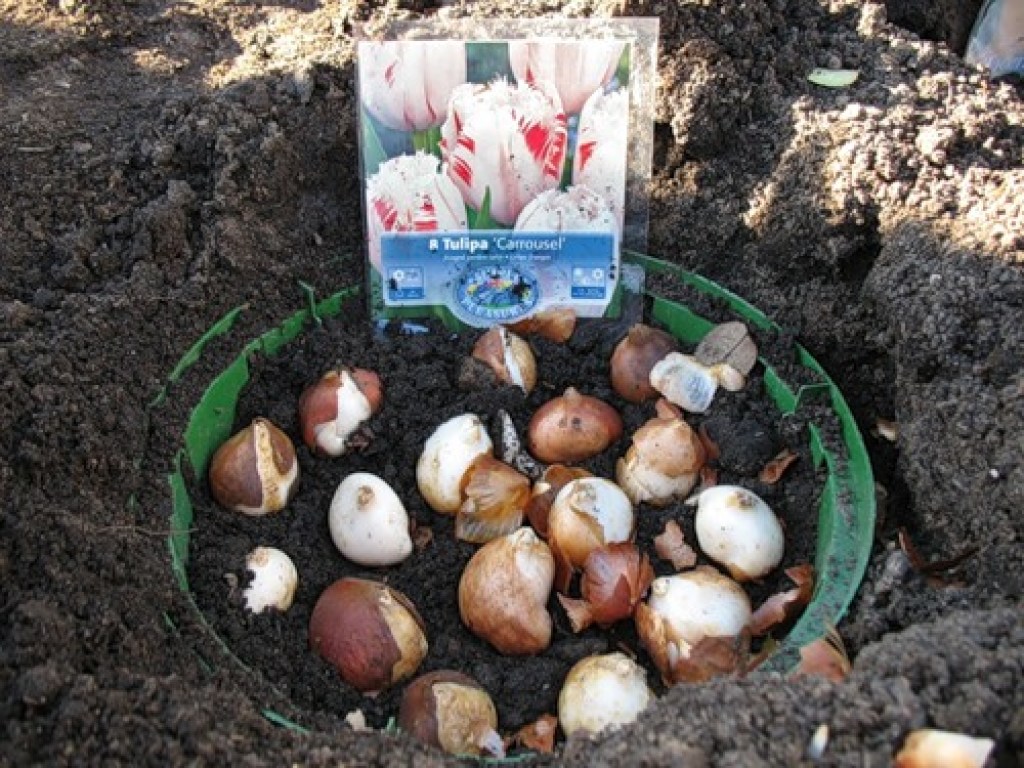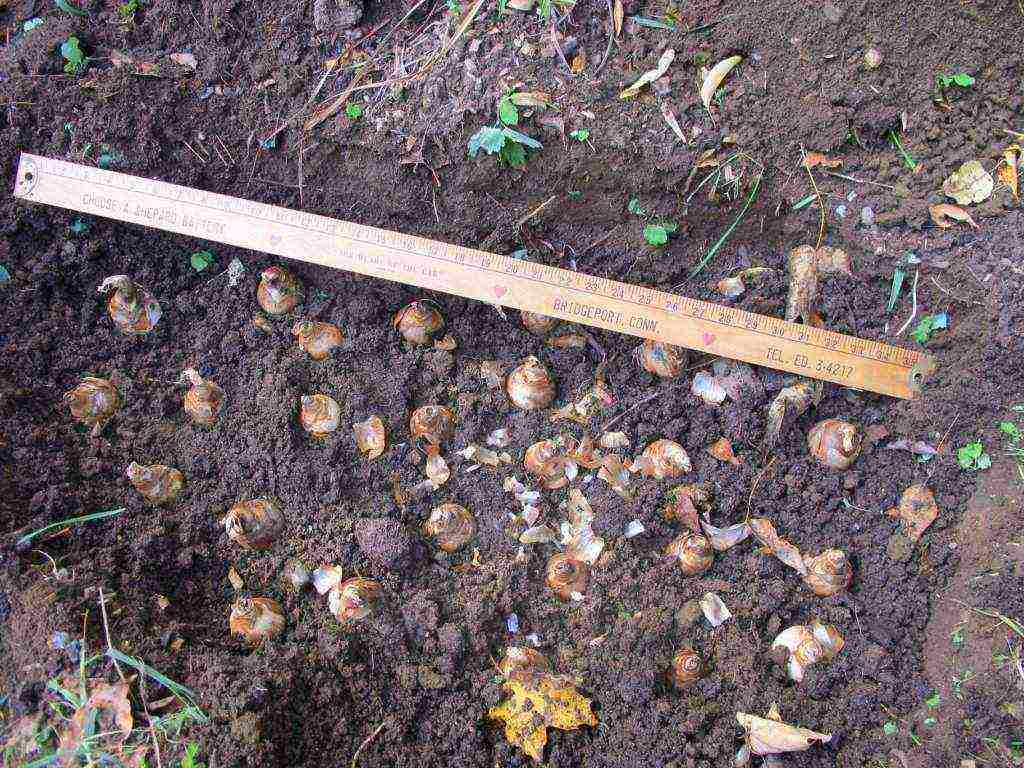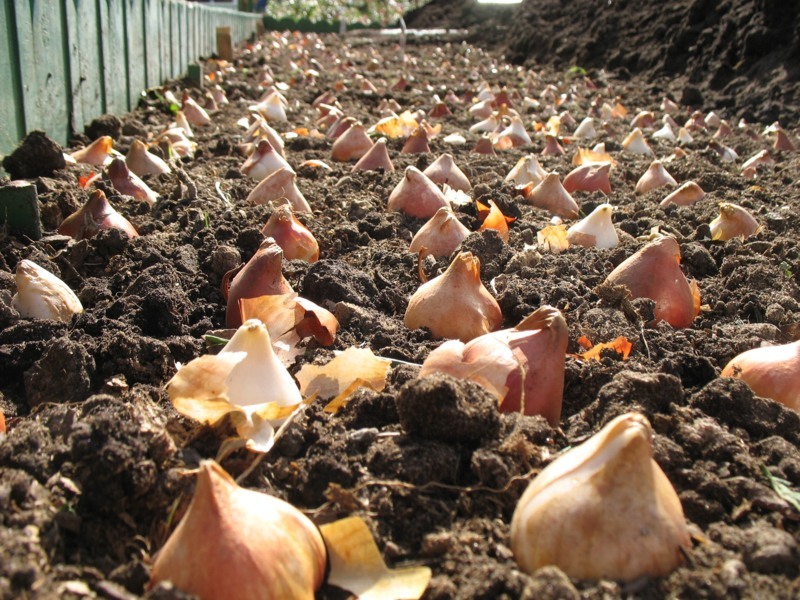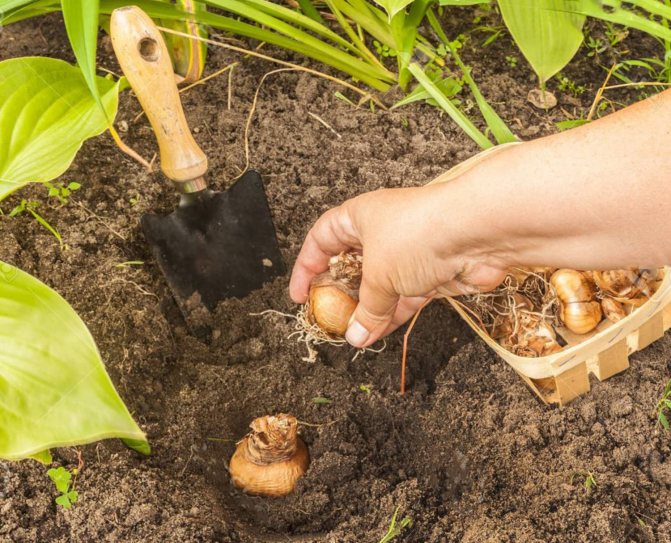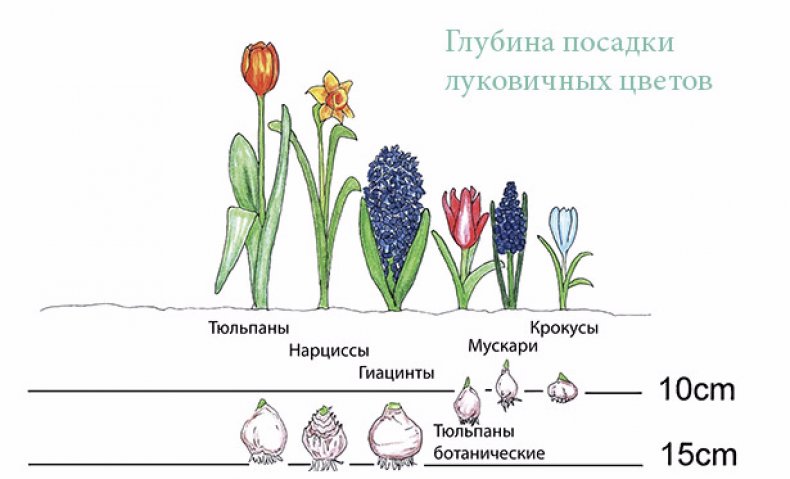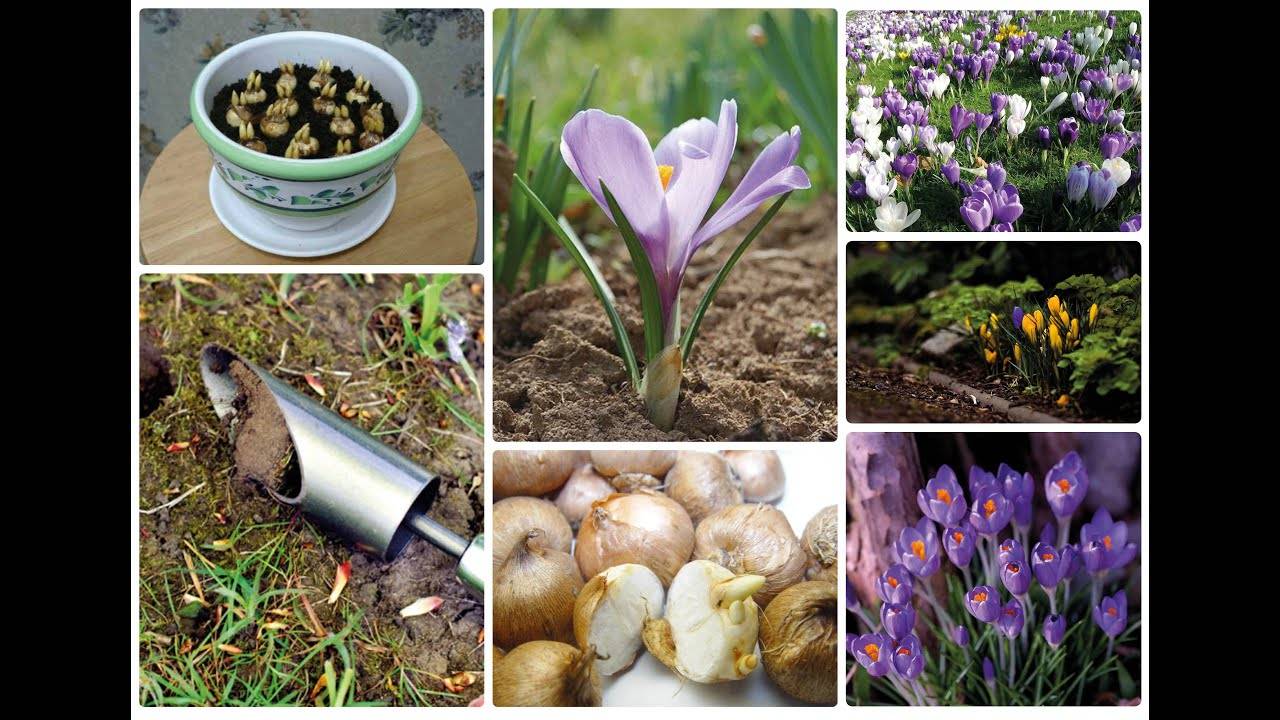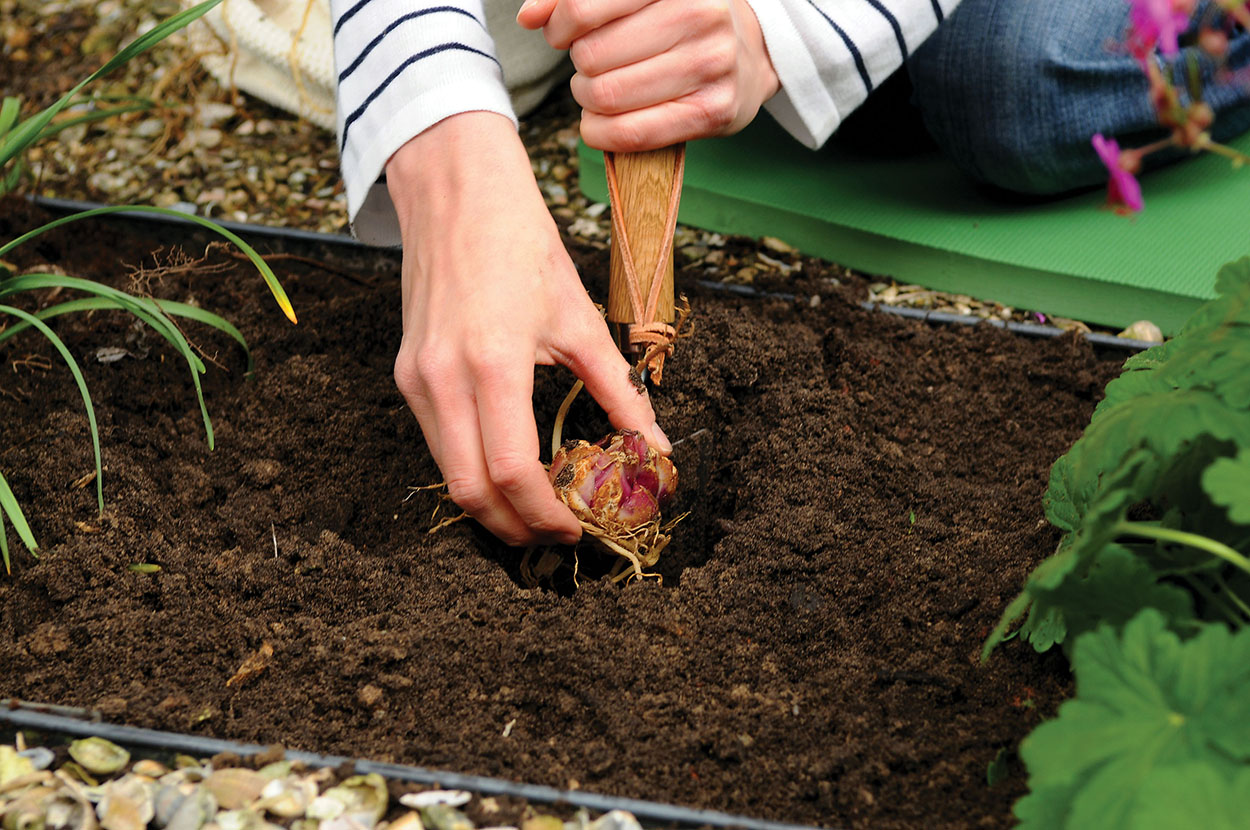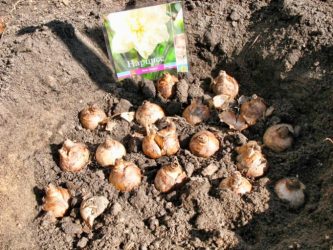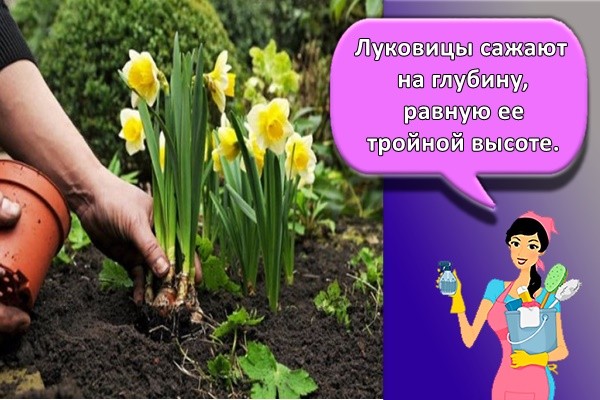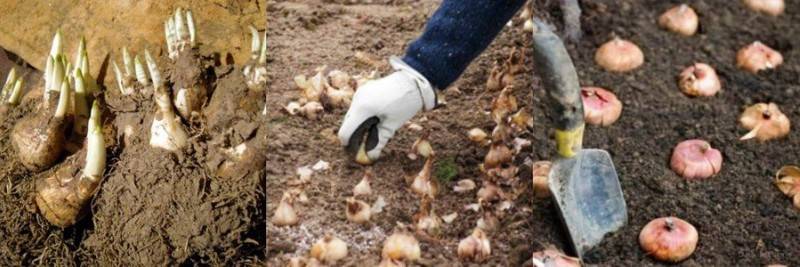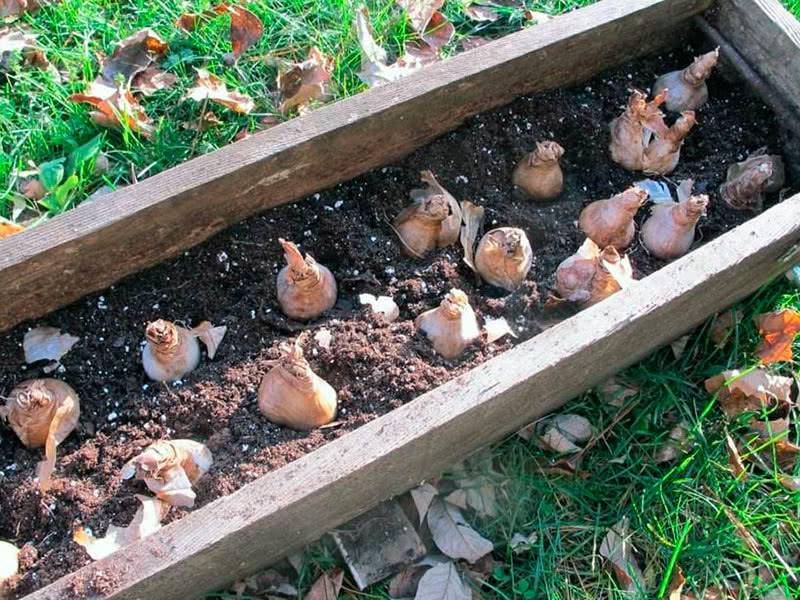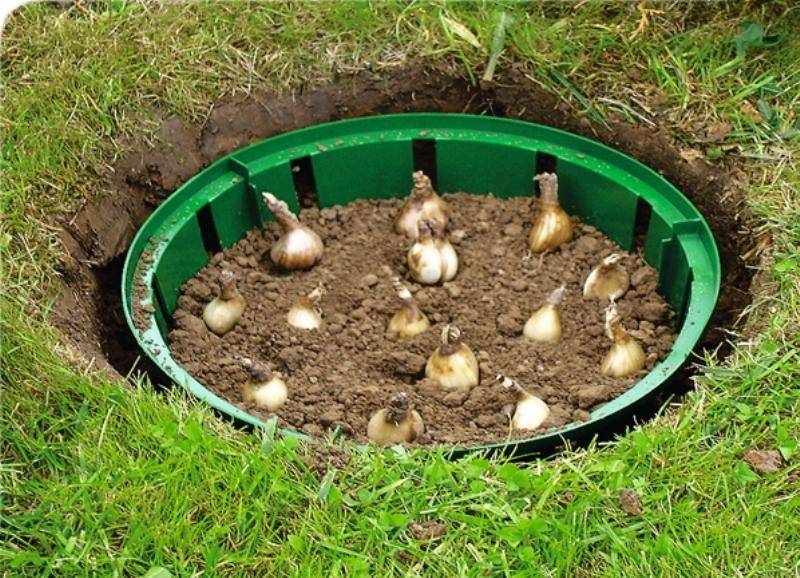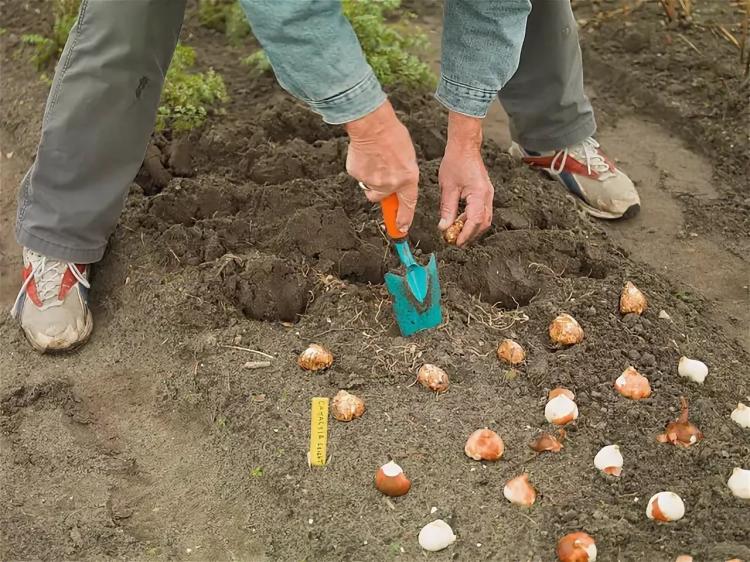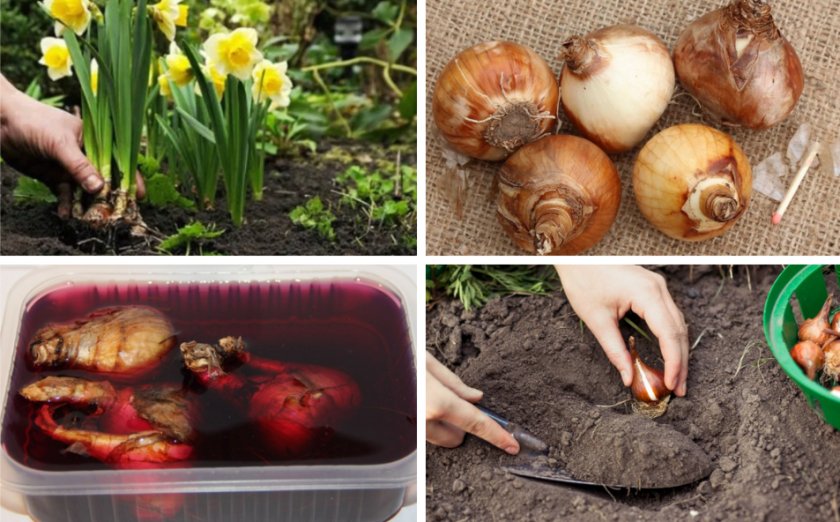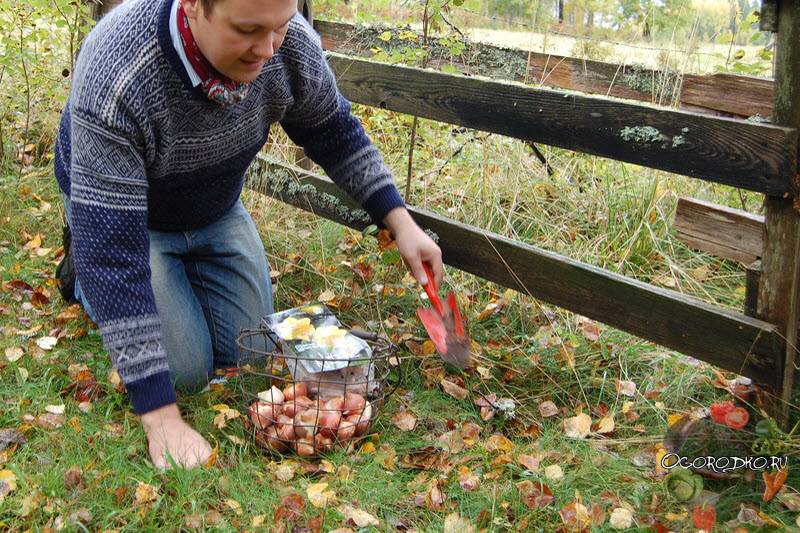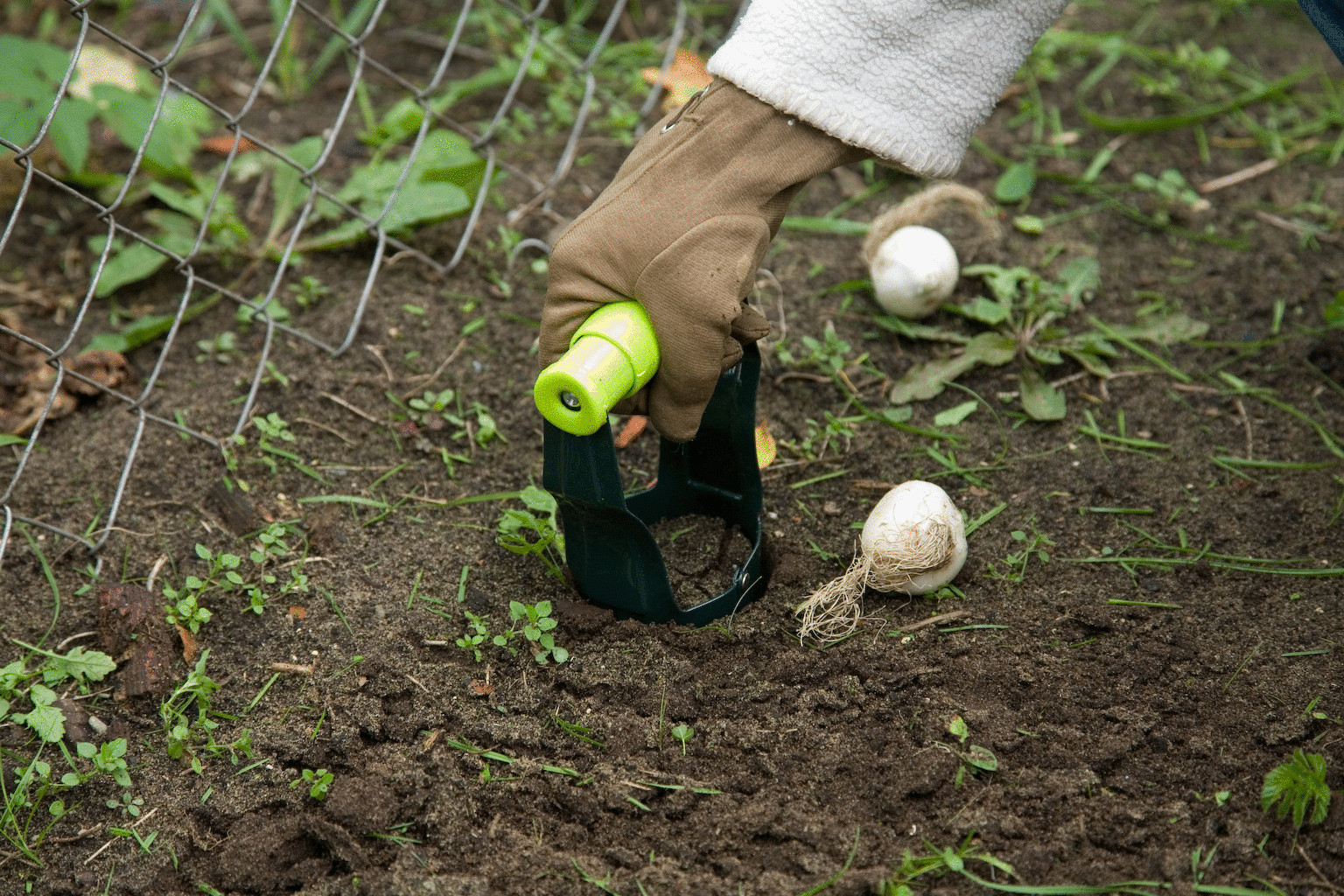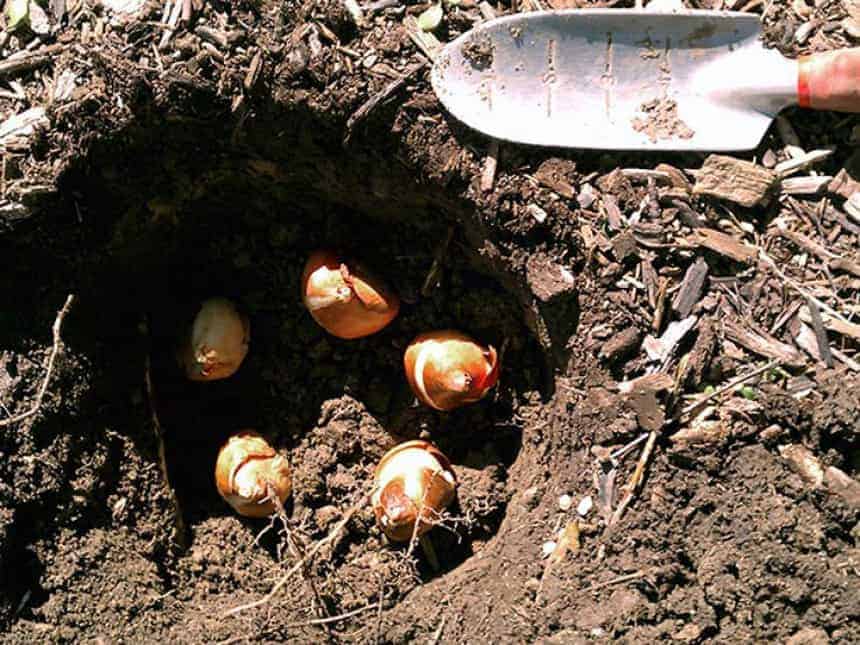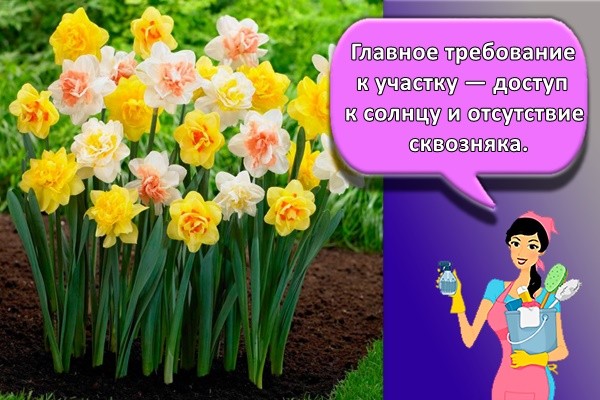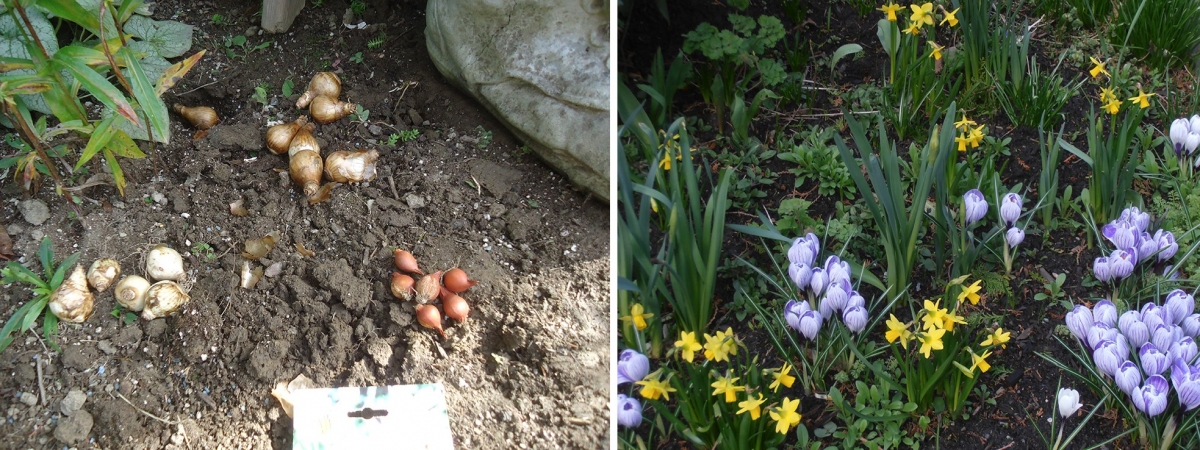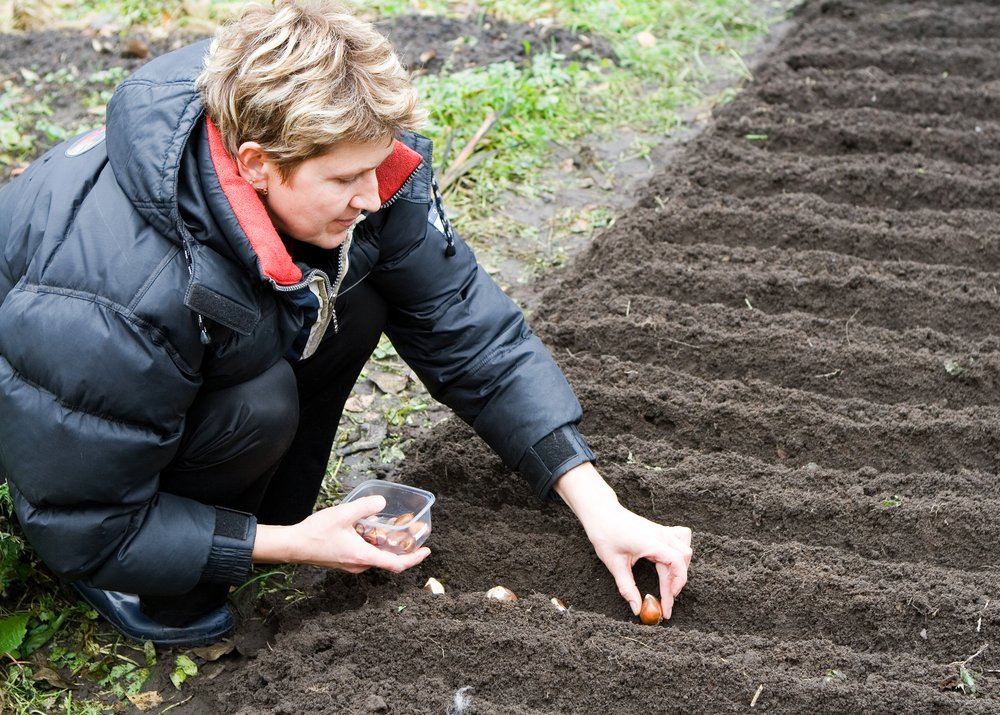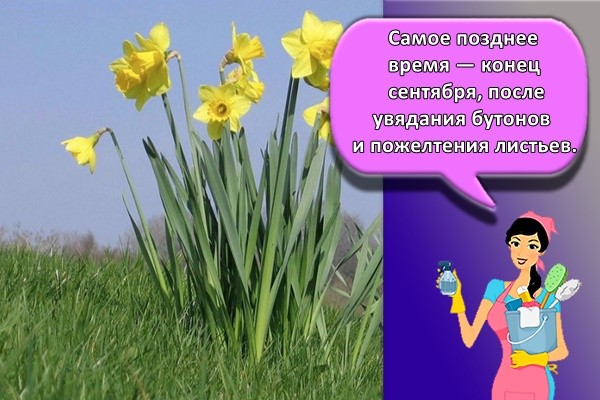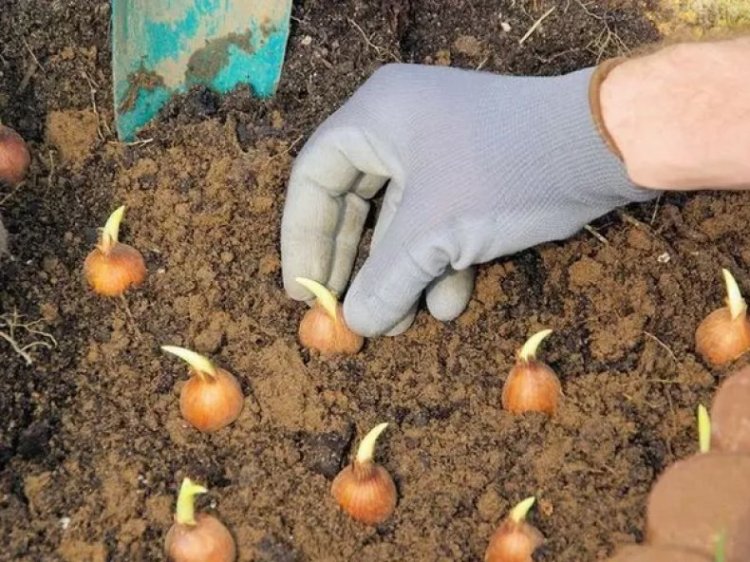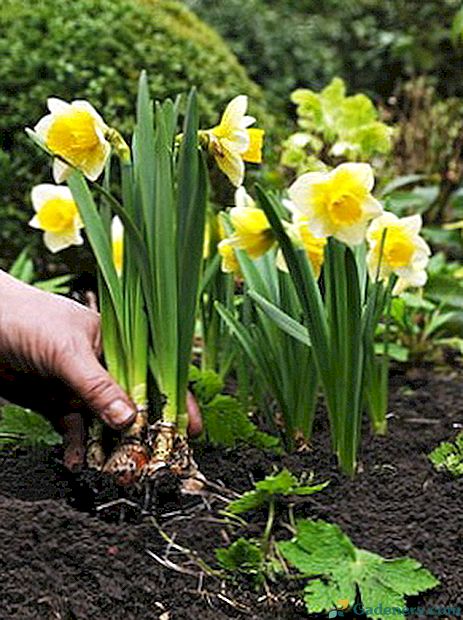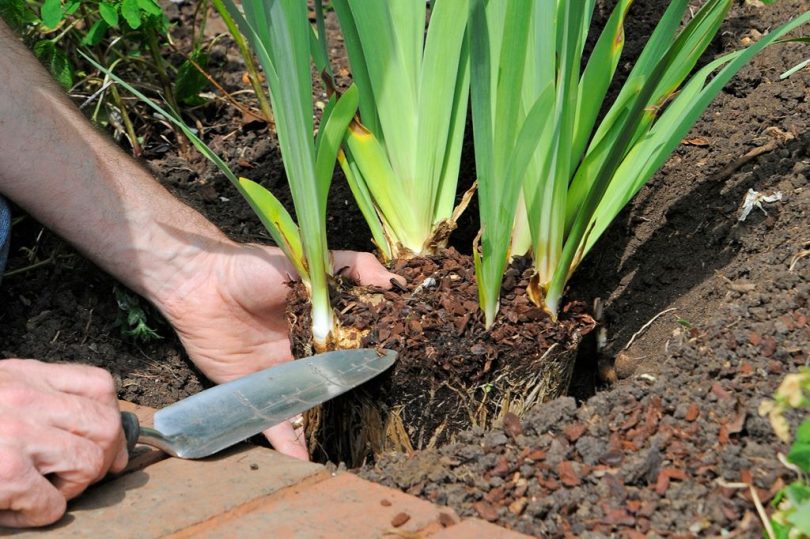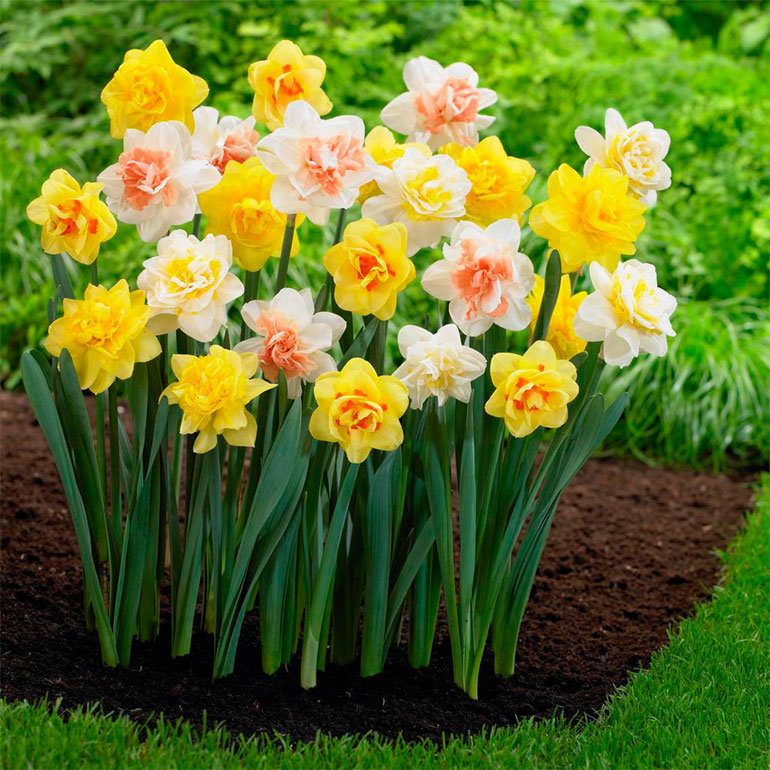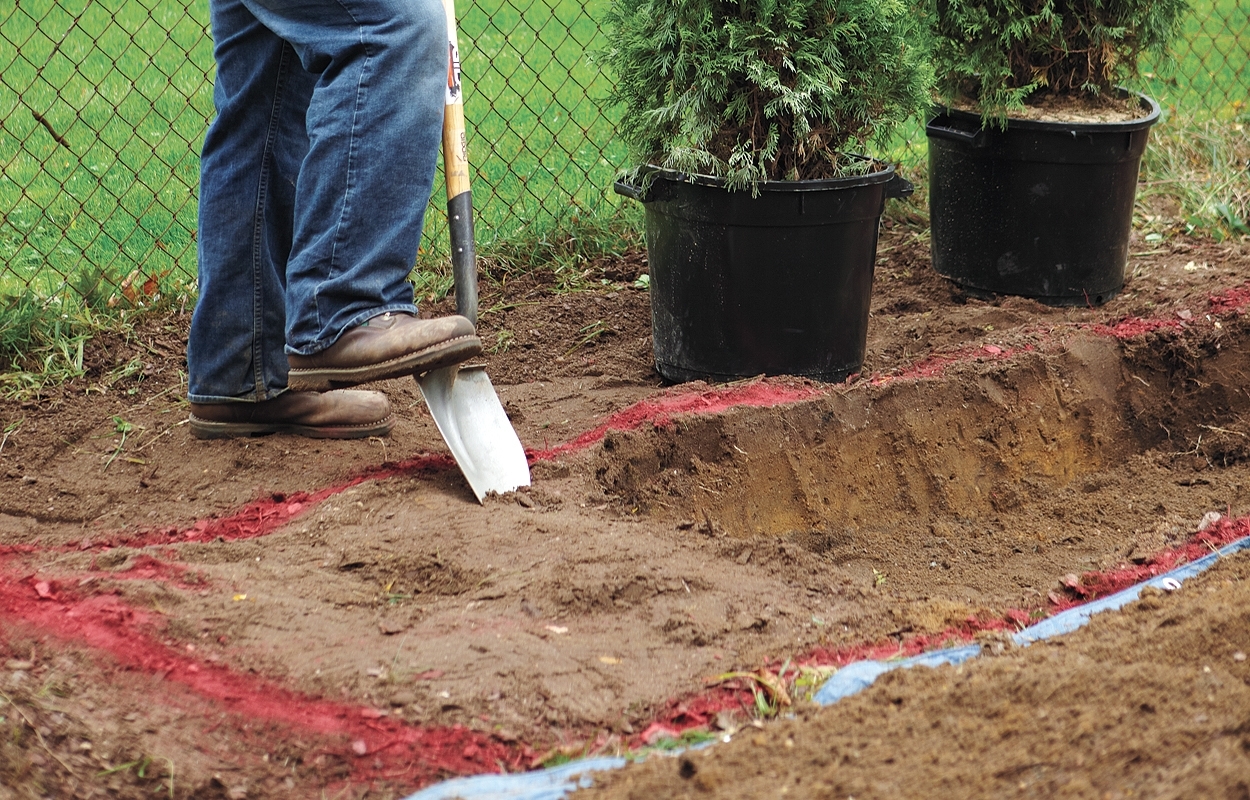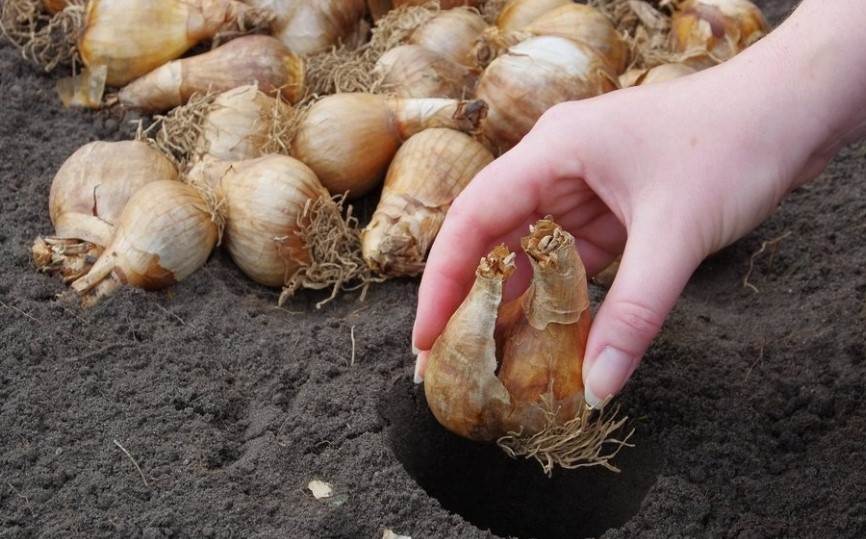What to do if daffodils have sprouted
When storing bulbs, it is important to regularly check their appearance. Timely removal of soft and stained specimens will save the planting material from infection with fungi and viruses
Sprouted bulbs can also be seen.
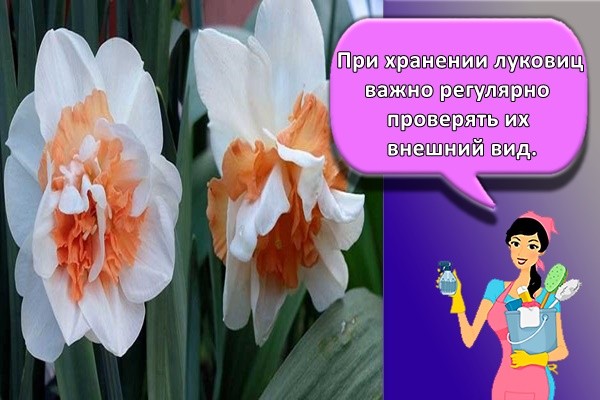
Reasons for sprouting bulbs outdoors:
- mild climate, warm autumn;
- planting too early in summer;
- prolonged thaw.
Bulbs wake up from the increase in heat and humidity in the storage, in unstable weather conditions. The process at the initial stage can be slowed down - move the bulbs to a colder place. In the garden, the thickness of the mulch layer should be increased by 2-5 centimeters, along the length of the sprout. You need to mulch after a cold snap, but before the temperature drops to -5 degrees. Germination indicates the development of roots, and digging them up will damage them. Therefore, it is better to leave the onions in the ground. Children from storage with sprouts 1-2 centimeters long will hold out until the time of planting, if they are transferred to a brighter place.
When to plant daffodils in the fall in the ground
Daffodil planting dates
You can dig up daffodils and divide their nests annually, or you can do this once every 3-4 years. These flowers are planted in autumn.
When to plant daffodils outdoors in autumn? What month to plant daffodils? On average, the planting time for daffodils is the interval between the second half of August and the second week of September, although in fact the timing of planting daffodils depends on the climatic conditions of the region and the weather, therefore, they may shift. The main condition that determines when to plant daffodils before winter is the soil temperature in the range of 8-10 ºC, which lasts for at least two weeks. With timely planting, the bulbs should have time to form roots before freezing the soil, but they should not start growing.
When to plant daffodils in the fall in the suburbs
For example, planting of daffodils in the fall in the Moscow region is carried out from August 15 to September 15, since it is at this time in the middle lane that the soil temperature reaches the desired level.
When to plant daffodils in autumn in the Leningrad region
At the same time, daffodils are planted in the ground in the Leningrad Region, although you can start planting a little earlier - from the second decade of August. Here again, it all depends on when the soil temperature drops to the thermometer mark of 8-10 ºC.
When to plant daffodils in the fall in the Urals
Planting of daffodils in the fall in the Urals, which one witty gardener called "the land of evergreen tomatoes", has been carried out since the first days of August. But if the autumn is warm, you can plant the bulbs at the same time as in the middle lane.
When to plant daffodils in autumn in Siberia
Planting of daffodils and tulips in autumn in Siberia is carried out from August to September, and at what dates to do this, be guided by the soil temperature and the weather forecast.
Growing daffodils in the garden
Where to plant daffodils
Areas should be open, well lit and free from cold winds. Daffodils can tolerate light partial shade and even bloom, just their peduncles will be longer, and the color of the flowers is brighter and more juicy.
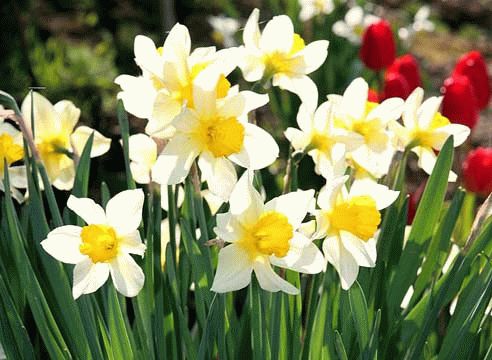
Blooming daffodils in the garden
Soil for daffodils in the garden
The soils should be well moistened, there should be no stagnation of water, so that the bulbs do not get wet. The landing site should have a drainage layer and a leveled surface. Almost any soil is suitable for daffodils, but still they feel more comfortable on heavy clay soils with the addition of sand or peat. Growing daffodils is also possible on peat soils, you just need to ensure a neutral acidity (pH 6.5-7).
It is strictly not allowed to use fresh manure just before planting, as this can destroy the adventitious roots of the bulb, and, accordingly, the death of the plant. Manure can be applied a year before the intended planting.
How to plant daffodils in spring - ways to grow
Daffodils grow well outdoors, although nothing prevents them from growing in pots and containers. They are frequent guests in the flower beds of continuous flowering. The main requirement of these plants for the soil is to keep it fresh. Daffodils propagate mainly by bulbs, although the option of sowing seeds is also possible, but this method rarely has practical application. But there are no problems with bulbs - in one year a single plant can grow up to six "babies"!

Due to this circumstance, flowers should be planted every 2-3 years, without waiting until they become so crowded that you will not see a single flower in the entire flower bed except for the tops. Try to prepare the soil for planting in advance by digging it up properly and adding humus. Even understated areas are suitable for these flowers - they tolerate short-term flooding of the soil with melt water quite well.
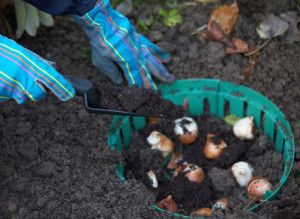
Reproduction of daffodils.
There are two ways of reproduction - seed and vegetative. Seed propagation is the longest way, plants will bloom only after 6-7 years. The dried seeds are planted in boxes of soil and looked after as if they were seedlings. In the first years, the sprouts do not touch, they allow the onion to grow stronger and form roots. Then they are transplanted to a permanent place.
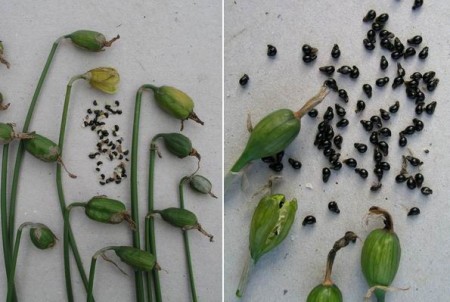
The vegetative method includes two options:
- separation of children from mother. They are seated in separate holes. They are looked after in the same way as for adult bulbs.
- reproduction using scales. To do this, take the largest bulbs and dry them for a week. Then the top is cut off and divided into eight parts. Each wedge should have two scales. They are folded in a bag and kept closed for 3-4 months, during which time small bulbs should form, which are planted in boxes with peat and sand.
Why daffodils don't bloom.
The plant may not bloom if not properly cared for.
There may be several options here:
- the bulbs are too closely spaced to each other;
- acidic soil;
- little light;
- stagnant water
- lack of moisture.
Diseases and pests.
Daffodils are susceptible to the following diseases - fusarium, gray rot, nematodes and streakiness. Processing the planting material before planting will get rid of the fungus. If the plant is infected with a virus, then it should be immediately destroyed. And immerse healthy bulbs in hot water for several hours.
A hoverfly, tick, fly, slugs harm daffodils. An insecticide will help against them.
What to do after flowering.
When flowering is over, the leaves should not be cut off, they should dry out.
After the leaves have dried, the bulbs can not be dug out, but the ground parts can be removed, the flower garden can be weeded, loosened and watered until autumn.
You can store bulbs intended for planting:
- in the cellar (they are planted in boxes);
- in the refrigerator (stored in a paper bag, checking for rot).
Features of planting daffodils in the open field
Most often, daffodils are grown outdoors. In order for them to please with their flowering, you need to decide on the place and time of planting. A well-chosen plot is the basis for good flowering.
Soil and planting site
Daffodils prefer neutral soil; light loam is good.
What if the site has the wrong structure and response?
- If the soil is heavy, it must be mixed with sand. Sandy loam is diluted with clay or black soil. In these cases, up to 15 kg per square meter is sufficient.
- The acidic area is preliminarily lime or wood ash is embedded in it. Alkaline soil leads to a neutral reaction by adding dolomite flour.Lime, ash and dolomite flour take approximately the same amount: from 1 to 3 glasses per square meter.
- On poor soil, elite varieties quickly degenerate and lose their characteristics. Ordinary ones become smaller and lose brightness. The land should be nutritious and well fertilized. Well-rotted compost or humus must be added to the site. For digging per square meter, 15 kg of compost or humus is enough with the simultaneous incorporation of a mineral complex fertilizer according to the manufacturer's instructions. It is not recommended to use fresh organic matter.
Daffodils grow in one place for 5 to 7 years. Grow quickly and bloom well in small groups. Therefore, the choice of location must be approached responsibly.
Recommendations when choosing a place:
- Light partial shade is the best choice. For example, the trunks of deciduous garden trees. Please note that under the open sun, plants fade, and a thick shade does not promote flowering;
- Planting plants should be on the leeward side - avoid open areas;
- Cannot be planted after tulips, crocuses, hyacinths and other bulbs. Good predecessors for them will be crops under which manure was applied.
Time to board
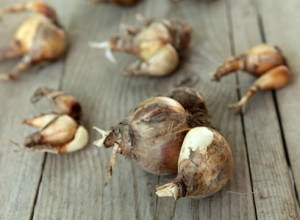
Daffodil bulbs
Daffodil bulbs are available all year round. The best time for this is considered late summer - early autumn, since it is during this period that the bulbs rapidly grow the root system. It will take up to four weeks for them to fully root.
Planting these plants in the fall will not be difficult and guarantees flowering for the next year. This requires:
- It is necessary to purchase planting material shortly before planting.
- After purchase, a permanent place in the garden is chosen for the bulbs.
- The soil is dug up deeply - by 35-40 cm. For the rapid development of the root system, it needs a loose, air-permeable soil.
- The bulbs are inspected before planting. Soft ones are discarded. Dense, outwardly healthy, soaked in a fungicide solution.
- After processing, daffodils are planted in the ground. The recommended planting depth for adult bulbs is about 15 cm. For all bulbs, the following rule can be used: plant at a depth equal to the height of 3 bulbs. Therefore, if the planting material is children, it is better to follow the general rule. When planted shallowly, plants grow rapidly, when planted deeply - slowly. Plants should not be planted too densely. Leave a distance of 10 to 20 cm. Thickened plantings bloom worse and will require transplanting ahead of time.
- For planting, holes or small grooves can be made. Pour sand to the bottom and pour abundantly with water. Lay the onion on top with the bottom down and sprinkle with earth.
- The area with the planted daffodils must be mulched so that the soil does not dry out: with bark, sawdust, cut grass. It will also help control weeds.
Spring planting differs from autumn planting:
- Landing is carried out when the ground is sufficiently warmed up. The average temperature is set at 5-7 ° C, there is no threat of recurrent frost;
- The bulbs must be kept in the refrigerator for about 2 months before planting.
Experienced gardeners do not recommend planting daffodils in the spring. In the spring, it is quite difficult to provide the required temperature regime. The plant will take a long time to root and is unlikely to be able to bloom in the current season.
How daffodils breed
Amateur gardeners resort to a simple method provided by nature itself - the separation of daughter bulbs. It allows you to preserve the varietal characteristics of hybrids, which the generative method does not guarantee. Reproduction of daffodils is combined with their transplant.
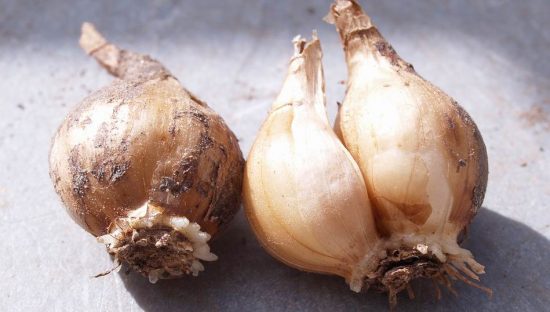
As a rule, the daughter bulb of a daffodil is separated from the mother bulb without effort, no damage remains on any of them.
Seeds of daffodils are propagated mainly by breeders who want to get a new variety. But if you have natural varieties, you can try it too.Planting material is harvested in the middle of summer. Plant the seeds immediately without letting them dry out. In the southern regions, it can be planted in open ground, in temperate climates it is better to grow daffodils from seeds at home, in containers filled with a mixture of peat, humus and sand (2: 1: 1). Seeds are sown at intervals of 4–5 cm, the seedlings that have appeared are not touched for one and a half to two years, allowing the bulb to form. When this happens, the daffodils are transplanted to a permanent location. They will bloom for the first time in 6-7 years after the emergence of seedlings from seeds, small-flowered species - in 4-5 years.
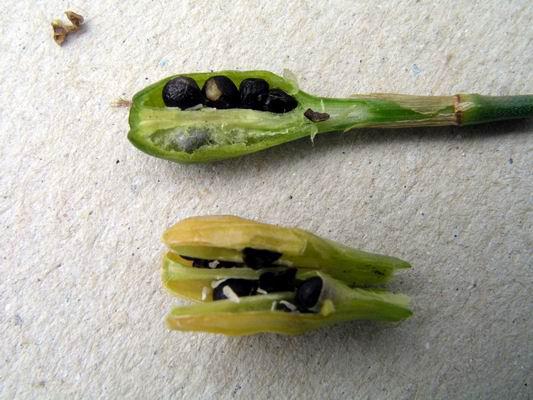
Growing daffodils from seeds is not popular among amateur gardeners - there is a much easier way to reproduce them.
Planting daffodils correctly
In order to correctly approach the planting of flowers, first you need to determine the type of your soil on the site, take into account the size of the bulbs themselves. The bulbs are planted to a depth of 13 centimeters (heavy soils, warm climate) and up to (26 centimeters, light soils, cold climates)
Plant the bulbs in such a way that the freezing of the soil does not touch them, and the groundwater does not wash away the root system.
Therefore, it is so important, when planting, to take into account all the positive and negative factors in the complex. Leave a distance between the rows of about half a meter, for convenience when caring for plantings
To get large children, daffodils are planted at a closer distance to each other, and at a smaller embedment in the ground.
To prevent your flowers from freezing, the soil after planting can be mulched; for this, peat mixed with humus and straw is used. And when the first frosts come, the flowerbed with plantings can additionally be covered with straw or dry grass, however, in early spring, the mulch is removed so that the plant can start growing without obstacles.
1 Brief characteristics of varieties
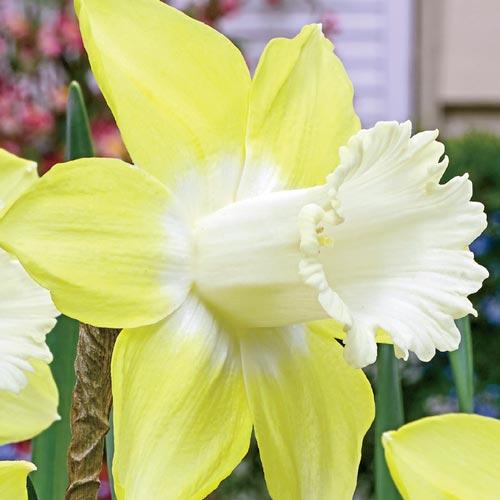
Narcissus group tubular
A general description of a plant of the genus daffodil can be presented as follows: perennial bulbous culture with a peduncle height of 10-50 cm.The leaves are linear, narrow, their length is 20-50 cm.Petals (perianth lobes) - 6, in the center of a flower with a diameter of 10 cm - round outgrowth in the form of a crown or tube, sometimes with a wavy edge. On each smooth stem - from 1 to 7 flowers of white, lemon, yellow shades with a delicate or brighter center (from white to salmon pink).
Depending on the shape of the perianth and crown, the number of flowers on the stem, daffodils are divided into the following groups:
- 1. Tubular. They are characterized by large single flowers with a diameter of 6-8 cm with a long expressive tube, along the length of an equal share of the perianth. Height - up to 50 cm.
- 2. Large-crowned. Large (up to 12 cm) flowers are arranged one at a time, the crown is wavy or even, making up about a third of the length of the petal, sometimes with a bright border.
-
3. Small crowns differ from the previous group in a shorter, often saturated, crown.
- 4. Terry - look very impressive thanks to the many petals arranged in rows. They can bear both one large and several smaller flowers on each peduncle.
- 5. Triandrus. They have a small height - up to 25 cm. Flowers - 2-3, medium-sized crown, 6 petals, slightly bent back.
- 6. Cyclamen - unusual with a thin elongated tube and drooping flower with curved petals, like those of a cyclamen. They are distinguished by early flowering.
- 7. Jonquilliaceae are a late flowering group. Flowers with a strong aroma, on the peduncle - from 2 to 6 pieces.
- 8. Tacettoids are also called multiflorous because of the many (up to 20) medium-sized flowers that each stem carries.
-
9. Poetic. Unpretentious, grow well, bloom late in single flowers. The most famous cultivar, Actaea, with white petals, a greenish-yellow crown and a bright red rim on it, is often found in gardens.
- ten.Bulbocodium hybrids are called "crinolines": their small flowers are located one by one on low (up to 15 cm) peduncles. The crown is wide, reminiscent of a crinoline skirt, surrounded by small petals.
- 11. Split-crown. A unique group with a wavy or fringed crown, which seems to be incised to a third of its length or more.
- 12. Other daffodils not included in any of the previous groups.
- 13. Species. They have a height of up to 20 cm, flowers - up to 5 cm in diameter. Often not hardy enough.
Reproduction
To quickly increase the number of daffodils on the site, use the method of reproduction by bulbous babies. Plants grown from seeds will bloom only after 3-4 years.
Children
One bulb produces 2-4 babies, which bloom in the first year. Signs of maturation in babies:
- the flower has grown;
- smaller buds compared to the previous year.
The division period is 3-4 years of plant life. They dig it out, separate the children and seat them. Separating babies is the easiest way to reproduce.
Seeds
Seed propagation is suitable for wild daffodils. Hybrids lose their species differences. The boxes are harvested in July and late autumn. After harvest, moist fresh seeds are planted in containers or open soil, laying deep into three diameters of the seed. The bulb is formed within 1-2 years. Then they are transplanted or transplanted from boxes into the soil in the garden. Flowers on seedlings will appear in 6-7 years, on small-flowered varieties in 3-4 years.
How to care for daffodils in the garden?
So, last fall, you prepared the soil in the right spot and planted daffodils. And in early spring, your flowers started to grow. As soon as you see the shoots, get ready for the first fertilizing with mineral fertilizer at the rate of 30 g per 1 m². The second top dressing (20 g per 1 m²) should take place at the end of May, during the budding period. If you want the flowering of daffodils to be long and abundant, you will need a third feeding, the composition is the same as the second. The fourth top dressing (2 parts of phosphorus and 1 part of potash fertilizer at the rate of 50-60 g per 1 m²) is carried out after flowering. Top dressing must be combined with watering and subsequent loosening of the soil. Otherwise, growing daffodils does not require any special knowledge or any special skills.
We advise you to read these articles:
Planting celery seedlings in 2020 according to the lunar calendar
Lunar sowing calendar for March 2020 of the gardener and gardener
Good varieties of cucumbers for open ground, self-pollinated
As for watering, daffodils love water, so they should be watered to the full depth of the roots - two buckets of water per m². After watering an unmulched area, it is mandatory to loosen the soil with the removal of weeds. This is the regime of caring for daffodils from the moment they emerge until the moment they fade. What to do next when the daffodils have faded? Water them and loosen the soil around them for another 2-3 weeks after flowering.

Tips for a lush bloom
Daffodils love moisture, so a lack of liquid in the soil negatively affects budding and flowering. For a lush bloom, it is recommended to moisten the soil under the bulbous flowers weekly or as the soil dries. It is possible to determine the level of soil moisture by the upper layer: the soil dried out by 2-3 cm needs to be moistened.
Remember to loosen the soil after each watering. The crust formed on the surface of the earth interferes with normal air exchange. Impaired air circulation, in turn, leads to a decrease in inflorescences or their complete absence. The soil saturated with oxygen and enriched with various nutritious and useful micro- and macroelements is an ideal environment for normal life of crops growing in the garden.
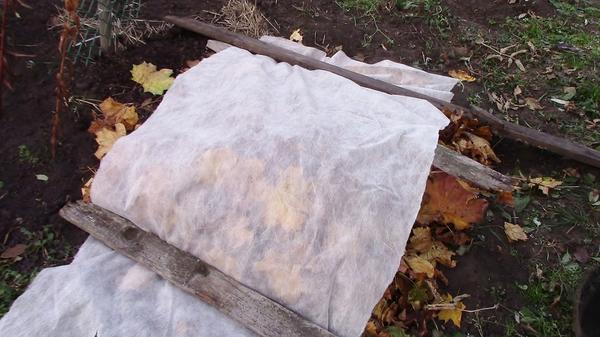
Proper preparation for wintering is considered one of the important stages in the care of flowering crops.Most varieties of daffodils - terry, cyclamen, triandrus, daffodil, etc. - need to be covered for the winter. The absence of a covering layer leads to glaciation of the upper layer of the bulbs, the plants stop developing or die altogether. Bulbous flowers, sheltered for the winter, will delight gardeners with lush and long flowering.
Planting daffodils in the ground before winter
Soil for daffodils
Planting a daffodil in the fall is preceded by site selection and soil preparation, which must be carried out in the summer. Loams are most suitable for daffodils, although they grow on other soils. The optimum soil acidity for daffodils is pH 6.5-7.0. On sandy soils, the bulbs gradually become small, and then flowering ceases altogether. In addition, sandy soils freeze deeper, which can lead to the death of bulbs in winter. But if the soil in your garden is cultivated, it is not difficult to prepare it for planting daffodils.
Humus and clay are introduced into sandy soil, and sand is added to heavy clay soils at the rate of 20 kg per m². Organic matter - humus, compost or rotted manure - is brought under digging to a depth of 25-30 cm at least three months before planting, that is, in spring or early summer. Humus will need about 15 kg, manure - 20 kg per m². Fresh manure can be applied to the soil no later than one year before daffodils are planted.
If you want to set aside a small area for daffodils, you can simply remove the topsoil in this place and replace it with special soil, bought in the store or compiled yourself.
How deep to plant daffodils
When you divide the bulbous nest of daffodils, then the planting material you get is of various sizes or, as experts say, of different analyzes. Planting depth is determined by the size of the bulb, making up three heights. That is, above the bulb placed in the ground, there must be a layer of soil equal to two heights of the bulb. For large daffodil bulbs it is 15-20 cm, for small ones - 10-15 cm. However, there are some nuances of immersion of the bulbs in the soil, allowing you to influence the flowering time and reproduction rate of daffodils.
For example, in order for the daffodil to bloom earlier, and its bulb is overgrown with the maximum number of children, you need to plant the bulb a little smaller than it should be according to the formula. If you want the flowers to open later and the babies do not grow as quickly, plant the bulb a little deeper than recommended. For those who are interested in the flowering of daffodils, it is better to plant the bulbs of the "extra" class, that is, large ones, and children are more suitable for the reproduction of rare varieties.
How to plant daffodils in the fall
So, in the spring you chose a sunny or semi-shady area, prepared it for daffodils, and now it's time to plant them in the ground.
How to plant daffodils? Dig holes in accordance with the size of the bulbs at a distance of 15-20 cm from each other if the planting material is large, and 7-10 cm if you are planting children. Place a layer of sand at the bottom of each hole, then spread the bulbs in them with the bottom down and lightly press them into the sand to make sure there is no void under the bottom. Sprinkle each bulb with wood ash, then fill the hole with soil by half, and fill the remaining space of the hole with the same soil, but with the addition of a complex mineral fertilizer with a predominance of phosphorus and potassium in an amount half the amount required by the instructions. If the weather is not rainy, water the area abundantly.
Diseases and pests of daffodils
Bacterial rots and viral infections can be a problem.
The first appear due to waterlogging, the introduction of fresh manure or an excess of nitrogen-containing fertilizers. The rot is clearly visible when digging up, they are cut out and the cut site is processed.
The latter are carried by leaf-eating insects or a tool when cutting flowers. The diseased plant stands out with multi-colored strokes on the petals and leaves.The specimen is immediately dug up along with the bulb, trying not to hurt other plants, and destroyed, because there is no effective cure.
Parasites for daffodils are nematodes (root and deciduous), as well as bear, slugs and daffodil fly. In the open field, insecticides are ineffective, but healthy and well-developed plants cope with the attack of insects.

As you can see, there are no particular difficulties with planting daffodils. An inexperienced beginner can also perform all actions. But in the spring, when the flower beds are full of yellow, orange or white flowers with a pink center, you will experience true aesthetic pleasure looking at such divine beauty.
Care rules
It is not enough to plant daffodils correctly, it is important to prepare the seedlings for winter. If the landing was carried out in Siberia or in the Urals, then you need protection against freezing
A shelter can be:
- peat;
- spruce branches or needles;
- oak foliage;
- sawdust or shavings;
- non-woven fabric (agrofiber, lutrasil).
The method of insulation is simple, so that the planting material does not die, the non-woven material is laid in 3-4 layers, the natural one is up to 10 cm and snow is thrown on top.
This approach guarantees a high survival rate of the bulbs. In spring they sprout quickly, bloom profusely and decorate the garden.
Rational watering
Watering is organized regularly, it is impossible to allow the soil to dry out or waterlogged, this will lead to the death of the culture.
Attention! "It is important to combine watering with loosening the soil so that a crust does not form and the roots receive the necessary oxygen"
Top dressing
Without feeding, it is difficult to achieve abundant flowering and proper plant development.
- In the period after the snow melts, a complex of mineral fertilizers is applied: superphosphate - 15 g + potassium - no more than 15 g + nitrogen - 30 g. During this period, there is enough water in the soil, so fertilizers are embedded in a dry form between the plants.
- The next feeding is necessary during the budding period, which enhances flowering. For this, a section of the garden with flowers is watered with a mullein hood in a ratio of 1:30. Superphosphate (15 g) and any chlorine-free potash fertilizers 15 g, for example, ash, are added to the container.
- The next top dressing is timed to flowering. It promotes the ripening of the bulb. A substance is being prepared, consisting of superphosphate - 25-30 g + 10 liters. water.
Attention! "It is important not to overfeed with nitrogen fertilizers and combine this procedure with watering."
Daffodil transplant
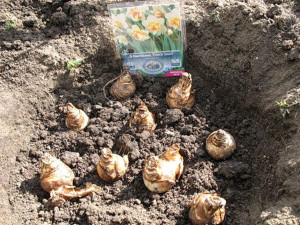
Planted after drying after 2 months
Plants planted according to all the rules delight with flowering in the same place for a long time. It is recommended to replant them not earlier than after 5 years.
The need for a transplant can be determined by the following criteria:
- daffodils began to throw out fewer buds or stopped blooming;
- the flowers were shredded, the quality of the flowers decreased.
Plants are also transplanted if the variety needs to be propagated.
For transplant:
the bulbs are dug up in August, after the natural death of roots and leaves;
cleaned from the earth and freed from dead parts - roots and leaves
Live roots are left on the bulb;
inspect: rotten, soft or damaged by pests are discarded;
healthy - washed and treated with a fungicide solution;
after processing, they are very carefully divided: the baby usually moves freely from the mother's bulb. If this is not the case, then the bulb is carefully torn off, and the place of rupture is sprinkled with wood ash;
then they are laid out to dry, during which possible wounds should heal
Any shaded area with free air access will do;
dried bulbs can be stored for a maximum of 2 months at temperatures up to + 17 ° C in a dark, well-ventilated room.
If stored for longer, moisture will evaporate from their surface. Dried bulbs cannot be reanimated. Therefore, 2 months after digging them, they are planted in a permanent place.
Follow-up care
For quick adaptation, good growth and abundant flowering, daffodils need care. Despite the excellent endurance and unpretentiousness to growing conditions, improper watering, lack of oxygen and micronutrients in the soil leads to a deterioration in the decorative qualities of the flower.
Flowers growing in the garden need to be fertilized several times per season. The first feeding with nitrogen-containing preparations is carried out in the spring, when the bulbs begin to sprout from the ground. The second and third stages of fertilization fall on the periods of budding and flowering. The last top dressing falls in the fall - it is at this time that the preparation of horticultural crops for the upcoming winter begins. In autumn, complex potassium-phosphorus mixtures are introduced into the soil.
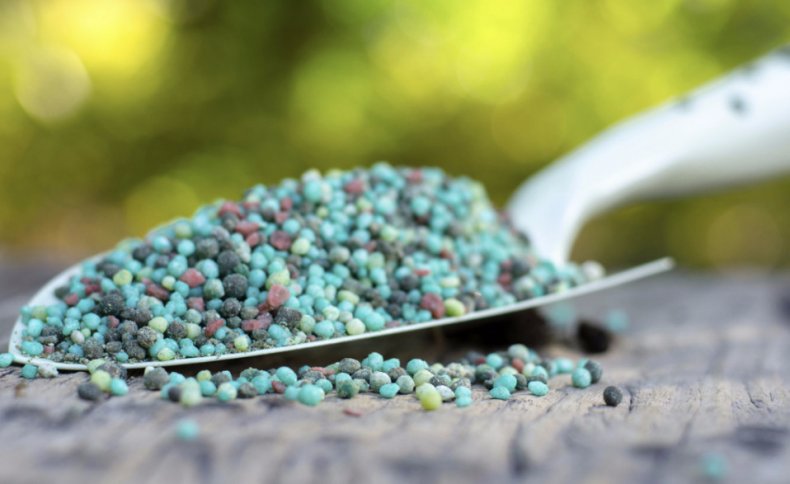
Agrotechnical secrets
According to cultivation techniques, daffodils cannot grow in one place for more than 5-6 years. In recent years, the duration of flowering has decreased, the buds have become smaller. For this reason, it is recommended to replant bulbous crops every 3-4 years. Cut daffodils are transplanted every year. Such flowers have long and firm stems, lush and large buds.
Every 4 years, daffodils growing in group flower arrangements are transplanted. When planting, the bulb is buried more than the recommended value. Ideal neighbors are peonies, violets, parsley and even carrots. It is not recommended to plant daffodils next to asters, daylilies and irises.
Watering and loosening the soil
Daffodils belong to the group of water-loving flowering crops. It is necessary to moisten the soil during the period of bud formation and at the flowering stage. After flowering, it is recommended to continue to abundantly moisturize the soil under the daffodils for another 1.5-2 weeks. However, if the summer is rainy and cool, the frequency of watering can be reduced several times.
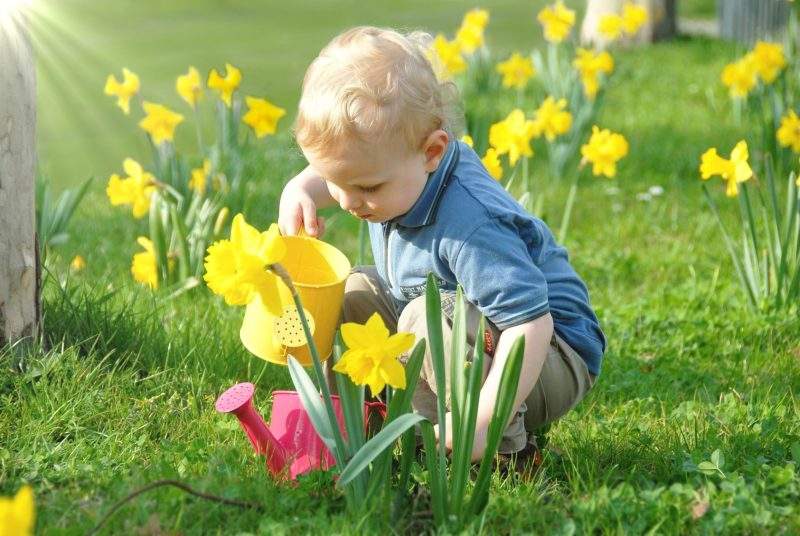
After each watering, flower beds need loosening and weeding. Removing weeds and loosening the topsoil are necessary measures for oxygen access to the rhizomes of flowers.
Major diseases
Following the rules of agricultural technology increases the resistance of crops growing in the garden to pathogens of various diseases and invasions of harmful insects. Occasionally, on daffodil beds, you can find signs of the presence of a lumpy hoverfly, daffodil fly, onion horse tick, cicada, whitefly and nematodes. For bulbous ornamental crops, fungal infections such as fusarium, gray rot, ring spot, penicillous rot, etc. are characteristic.
It is possible to prevent the appearance of harmful insects on flower beds and the development of various diseases by prophylactic treatment of plants with insecticidal and fungicidal preparations of a new generation.
Preservation of bulbs
You can dig up the bulbous flowers at the end of the flowering stage, when the leaves turn completely yellow and begin to peel off easily. First, the daffodil tubers are dried in a well-ventilated area out of direct sunlight. Then the bulbs are cleaned: loose and dry scales are removed.
The rhizomes treated with potassium permanganate are stored in cardboard boxes or wooden boxes. At first, the average air temperature in the room should be within +24 ° C, in winter and early spring - no higher than +14 ° C.
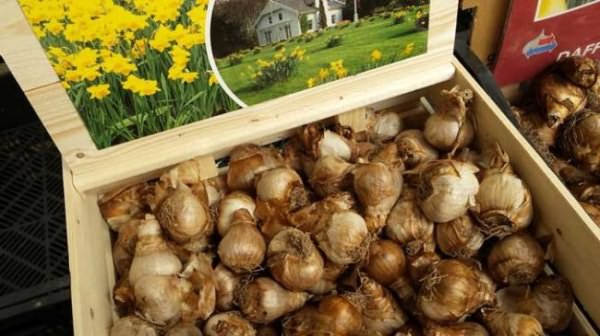
Planting and care in the open field
Daffodils should be planted in fertile soil saturated with humus. The place should be chosen such that the wind does not blow there, but the rays of the sun fall - so reproduction will be more active. Landing in partial shade is allowed. The plant does not tolerate frosts, therefore in winter it is worth either digging it up and moving it into the house, or insulating it with burdock leaves.

Landing dates
Planting daffodils is recommended in August or early autumn (early September). This is the optimal time, but, due to its unpretentiousness, you can also plant them in the spring (at the beginning of April).The main thing is to monitor the temperature: the flower does not like cold, therefore planting in winter is undesirable.
Important! To prevent the development of fungal diseases, the flower bulbs are soaked in a solution of potassium permanganate before planting (dilute 4 crystals of potassium permanganate in a liter of water and place the plant there for 1 hour).
Processing before planting
Before planting a daffodil, you need to add humus, peat or clay to the soil (in proportions 1: 2). Thanks to this, the flowers will grow and multiply more actively. At the bottom of the hole, add 5 cm of sand and press each onion into it a little. This will provide a strong impetus for growth and protect the sprouts from pest attacks in the first seasons of life.

Temperature
For rapid growth, an air temperature of about + 13 ° C is required. For a supply of nutrients in winter, so that the flowers quickly grow stronger in spring, it is recommended that the temperature is not higher than + 9 ° С, but also not lower than 0 ° С.
In the spring, they should be warm and in the sun. Strongly windy and cold place is contraindicated.
Find out also when to plant daffodils in the suburbs.
Planting in open ground
To plant flowers from a pot into the ground, you need to adhere to a few simple rules:
- Plants from the pot should be planted in the prepared ground, in partial shade, since the flower standing in the house is not used to the direct rays of the sun and will quickly fade.
- Do not plant them next to a large number of bushes and trees, otherwise the inflorescences will be small, and the flowering time will be reduced, since daffodils need a lot of free space to grow.
- You cannot plant them in a place where groundwater passes close: the soil should not be flooded from the inside, otherwise the risk of developing fungal diseases will increase.

Loosening the soil and watering
After planting and adding peat, the soil between all the sprouts should be carefully loosened.
Watering is necessary for the entire length of the roots. That is, pour as much as the earth itself and flowers will take. But you can't fill it, otherwise the plant will disappear: 100 ml is enough for one bush. After flowering, watering should be continued until winter.
Did you know? According to the language of flowers, daffodils stand for "selfishness" or "fruitless expectation."
Fertilizers
For the first year, you should not feed the plants, because during this first flowering cycle they will use their own reserves, and then, in other periods, they will be taken from the outside. You can fertilize daffodils with nitrate with ammonia, potassium, phosphorus. You cannot add manure, as the bulbs will deteriorate and rot from this.

Pruning
Do not pull out the foliage near the bulb with your hands. You need to take a knife or pruner and carefully cut off the wilted parts of the flower. It is also forbidden to remove and touch still green leaves - this can adversely affect the plant bulb, which also accumulates useful substances through the aerial part.
When cutting off, you need to hold a part of the onion with your hand so as not to damage it and not accidentally pull it out.
Growing daffodils in the garden
How to grow daffodils
Daffodils appear early in the garden, one of the first, along with hyacinths, crocuses and tulips. The flower itself is not capricious, but it is better for sloths not to mess with it, because only a responsible florist can grow a daffodil the way it should be
It is very important to choose a suitable site for planting daffodils: it must be well-lit, permeable, the most favorable soil is neutral loam, fertilized with compost or humus, but not manure. If the soil is too alkaline, you can add dolomite flour to it at 200 g per square meter, and the increased acidity is reduced with wood ash at the rate of 1 cup per 1 m²
Do not plant daffodils where tulips, lilies, or other bulbs have recently grown, as well as perennial asters, phloxes, and chrysanthemums. But after cereals, legumes, nightshades, peonies and cucumbers - please.
Daffodil bulbs
When warm days come, daffodil bulbs are planted in the ground.In the spring, many stores sell stale goods for a song, and this is a good chance to buy the bulbs of rare varieties of daffodils cheaply. Just be careful: do not buy soft or weakened bulbs that may not sprout at all, but if the plant, despite your fears, does grow, try to pay more attention to it. The best time to buy daffodil bulbs is three months after flowering.
How and when to plant hyacinths so that they bloom in the same year
It is undesirable to buy bulbs:
- in the spring;
- those that were dug up with stems, flowers and roots during flowering or immediately after;
- multi-peaked, if it has only one large onion, and the rest are small;
- which have already shown a sprout.
In the photo: Blooming daffodil in a flower bed
Before planting, daffodil bulbs should be examined and discarded too soft, diseased or damaged, with an affected bottom. Healthy ones for disinfection are kept for half an hour in a three percent solution of a fungicide or a one percent solution of potassium permanganate.

